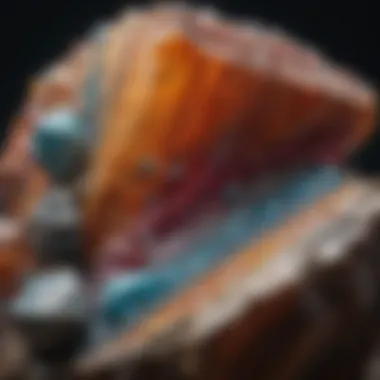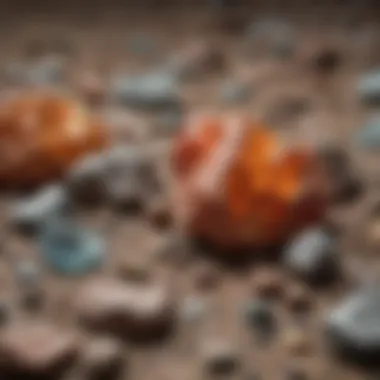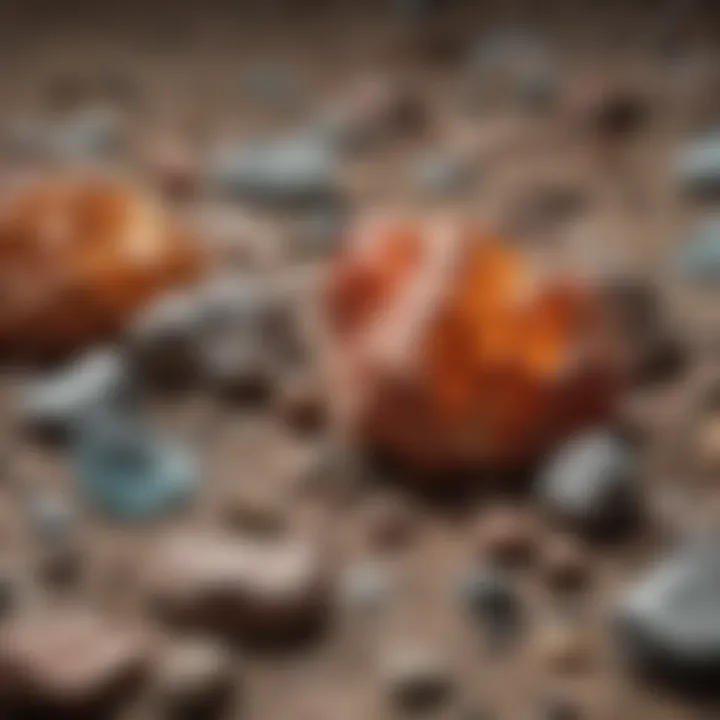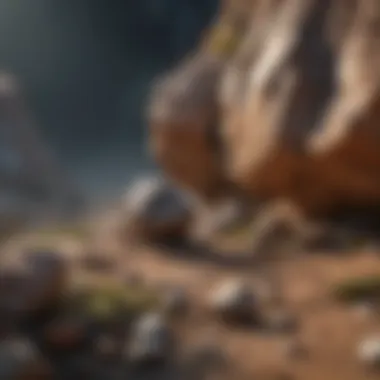Distinctive Features of Unique Rock Collections


Intro
Rock collections are more than just clusters of minerals; they are windows into the Earth's history, each specimen telling a story of formation, alteration, and sometimes, of entire ecosystems. For collectors and enthusiasts, the spark ignites with a single rock, leading to the intricate world of geological marvels that captivates like few other pursuits.
As we embark on this exploration of unique characteristics found within rock collections, we will discuss the defining features of various mineral types and their geological formations. Understanding these aspects not only heightens the appreciation for the beauty of rocks but also illuminates their significance within the broader tapestry of natural history.
History and Origins
Overview of Collectibles, Rocks, and Fossils
The allure of rocks and fossils stretches back to ancient civilizations. From early man’s curiosity about what lay beneath his feet to modern-day collectors scouring the landscape, the fascination with these natural artifacts has been unwavering. Historical records indicate that people have long valued rocks and fossils for their aesthetic appeal and mysterious origins. In many cultures, stones were seen as bearers of power or talismans, often used in ritualistic contexts.
Today’s rock collections can be incredibly diverse, spanning everything from the humble pebbles found on a riverbank to the dazzling gems displayed in showcases. Fossils, too, tell a tale that transcends time, revealing clues about the environment millions of years ago. As seen in notable collections like those housed at the Smithsonian National Museum of Natural History, these specimens not only enrich scientific knowledge but also provide cultural and historical context to our understanding of Earth’s geological evolution.
Historical Significance and Cultural Impact
The significance of rock collections goes beyond the personal; they often symbolize the intersection of science and culture. Take, for instance, the famed mineralogical collections from European aristocracy in the 17th and 18th centuries. These collections were not merely decorative; they served educational purposes and reflected the collector's social standing. Rocks and fossils were key components in the growth of disciplines such as geology and paleontology.
The impact of these collections continues today as educational institutions and museums use them to inspire future generations. Each exhibit is carefully curated to highlight the relationship between rocks, natural history, and humanity. The stories behind these specimens provide insight not only into the physical properties of the Earth but also into human curiosity and the quest for knowledge. As collectors, there’s a profound richness in embracing this legacy.
Identification and Classification
Guide to Identifying Rocks and Fossils
Understanding how to identify and classify rocks is fundamental for any serious collector. The process often begins with observing key characteristics such as color, texture, and mineral composition.
- Color: This might be the first thing that draws attention; however, it can be misleading as weathering might change it.
- Texture: Is it smooth? Coarse? Glassy? Texture tells you a lot about its formation.
- Hardness: Using the Mohs scale can help determine how resistant it is to scratching.
- Luster: How does it reflect light? This can guide you toward its mineral origins.
Knowing these identifiers creates a foundation for recognizing and categorizing various specimens. Moreover, encompassing an understanding of geological time can aid in contextualizing where these rocks fit in the Earth's timeline.
Common Types and Variations
There are numerous types of rocks and fossils, and an understanding of these can enrich a collection significantly.
- Igneous Rocks: Formed from cooled magma, examples include Granite and Basalt.
- Sedimentary Rocks: Often layered and containing fossils, common ones are Limestone and Sandstone.
- Metamorphic Rocks: Rocks transformed by heat and pressure, like Marble and Schist.
Fossils, in particular, can vary vastly, ranging from preserved bone fragments to intricate leaf impressions. Each type holds its own narrative—a brief encounter with the life forms that once inhabited Earth.
Defining Uniqueness in Rock Collections
Understanding what makes a rock collection unique is fundamental for both collectors and enthusiasts. Rock collections are not mere assemblages of stones; they tell stories that span eons, encapsulating the geological and cultural narratives of our planet. Each rock has its distinct characteristics based on a multitude of factors such as formation processes, mineral composition, and historical context. This section sheds light on why defining uniqueness is vital in appreciating the broader significance of rock collections.
Concept of Uniqueness
When we consider the concept of uniqueness in rock collections, we step into a complex interplay of natural processes and human interpretation. Uniqueness can manifest in various forms; it can be inherent to the rock due to its rarity, or it can stem from its provenance – the history of where and how it was acquired.
For instance, a pebble found on a remote beach in British Columbia may be just like others in terms of mineral composition but carries a value beyond its physical attributes. It may have been collected during a pivotal life moment or inherited from a beloved individual, making its emotional resonance significant. Therefore, uniqueness in rock collections is not solely about the rock itself but involves the interplay of personal stories, cultural backgrounds, and geological significance.
Rarity Versus Abundance
The relationship between rarity and abundance impacts how collection enthusiasts prioritize their specimens. A commonly found rock, such as basalt, might be abundant in various regions, but when a collector manages to find an unusual formation of it with exceptional details, that specimen instantly gains unique status. On the other hand, rare minerals like painite—once thought to be the rarest gem—instantly becomes a star attraction within a collection due to its scarcity.
To better articulate this point:
- Rarity: Often increases a specimen's value, both monetarily and sentimentally. Rare specimens often draw attention and admiration, enriching discussions among collectors.
- Abundance: Common rocks, while still valuable, may not garner the same level of intrigue unless they exhibit exceptional qualities or unexpected characteristics.
This interplay between rarity and abundance adds an intriguing layer to rock collecting, making the pursuit an engaging endeavor.
Cultural and Historical Importance
Rocks can be windows into the past. They tell tales of ancient ecosystems, geological movements, and even human history. Take, for instance, a simple flint arrowhead collected by an archaeologist or a piece of stone from the Great Wall of China. Each of these artifacts holds a historical narrative woven into its very existence.
The cultural significance might also reflect community practices surrounding rock collection. Some local traditions cherish specific rocks, believing they hold spiritual healing properties or serve as talismans. This cultural lens glorifies certain specimens, elevating them beyond mere minerals into cultural artifacts.
"Collecting rocks isn’t just a hobby; it’s a bridge to our earth's rich history and a canvas illustrating human stories across generations."
In summary, understanding uniqueness in rock collections requires an appreciation of both the tangible and intangible aspects of rocks. It involves grasping how geological narratives, historical contexts, and personal stories intertwine, creating a nuanced tapestry that defines what it means to collect rocks. As we delve deeper into this world, the layers of meaning and significance only deepen.
Types of Unique Rocks
Understanding the varieties of unique rocks is crucial in the realm of rock collecting. Each type of rock—igneous, sedimentary, and metamorphic—carries its own story, unique features, and connections to the geological processes that formed them. This categorization helps collectors appreciate the nuances of their collections, guiding them in both selection and representation of these natural wonders. This section invites you to explore each type and uncover their distinctive aspects.


Igneous Rocks
Formation Processes
Igneous rocks arise from molten magma that cools and solidifies. This process happens either below the Earth's surface, creating intrusive rocks like granite, or on the surface after a volcanic eruption, resulting in extrusive rocks such as basalt. The crystallization of minerals during cooling gives igneous rocks their unique textures. Notably, the rate of cooling impacts the crystal size, with slower cooling allowing for larger crystals, like those seen in granite.
The historical significance of igneous rocks cannot be overstated, as they form the backbone of many mountain ranges and are often rich with minerals that can reveal valuable insights about the Earth's crust. What makes studying the formation processes especially engaging is the variability in textures and colors that result, showcasing the diversity within this rock category.
Examples of Unique Specimens
Among the standout examples of igneous rocks are the exquisite obsidian and pumice. Obsidian, with its smooth, glassy appearance, is not only visually captivating but also tells the tale of rapid cooling - a process that leaves no time for crystal formation. In contrast, pumice is characterized by its light, frothy texture, a product of trapped gases during volcanic eruptions. Collection of these specimens not only enhances a display but also serves as a reminder of the fierce geological forces at play.
These unique igneous specimens are valued not just for their aesthetics, but also for their historical and geological narratives. Their weighty stories make them much sought-after amongst collectors eager to connect with the magma beneath our feet.
Sedimentary Rocks
Fossilized Remnants
Sedimentary rocks are a treasure trove for those fascinated by the Earth's history, particularly because they often contain fossils. These remnants of ancient life offer crucial clues about past ecosystems and climate changes. Fossilized remains, like those found in limestone and shale, can tell us stories from millions of years ago, revealing the types of organisms that existed and the environments in which they thrived.
What’s significant here is understanding how these fossils forge a link between collectors and the bygone eras they represent. Each fossil, no matter how small, contributes a piece to the grand puzzle of Earth’s history, allowing collectors to engage in an ongoing dialogue with the planet’s past.
Notable Locations
Certain locations are renowned for their sedimentary rock formations. For instance, the cliffs of Dover in England or the Badlands in South Dakota are celebrated not just for their beauty but also for the rich assortment of fossils they harbor. Collecting from these notable areas allows enthusiasts to take home a slice of history while also contributing to their understanding of the rocks’ geological context.
When collectors visit these sites, they often find that the experience is about more than just physical specimens—it's about connecting with the location itself and appreciating its role in the Earth’s geolological story.
Metamorphic Rocks
Transformation Processes
Metamorphic rocks are born from the transformation of existing igneous, sedimentary, or even other metamorphic materials, under extreme heat and pressure. This metamorphosis can alter the mineralogy, texture, and even the chemical composition of the original rock, leading to stunning varieties like schist or marble. The processes of metamorphism illustrate the dynamic forces at work beneath the Earth's surface, and each rock holds evidence of its transformative journey.
This transformation is what garners the interest of many collectors. The striking difference between a raw granite and a polished slab of marble, for example, speaks volumes about Earth's geological activities. Such processes highlight the interconnectedness of rock types and the multilayered narrative that rock collections can present.
Their Aesthetic Appeal
The aesthetic qualities of metamorphic rocks often draw collectors in. Their unique patterns and colors can captivate the senses, showcasing nature's artistry. For instance, the swirling colors of gneiss can look almost like a canvas of abstract art, while the translucence of certain marbles has made them a favored choice for sculpting and architecture.
Collectors appreciate these visual features for more than just looks; they often reflect the geological history of their formation. The intricate patterns tell stories of environmental changes that have occurred over millions of years, linking both beauty and science in a single specimen.
In summary, the exploration of unique rocks offers an essential perspective within rock collecting. From the fiery origins of igneous rocks to the layered narratives found in sedimentary and metamorphic samples, each type enriches a collection with their distinct characteristics and stories, enhancing both understanding and appreciation of Earth's complex geological tapestry.
Criteria for Assessing Rock Uniqueness
When evaluating the uniqueness of rock collections, it becomes essential to articulate clear criteria. These criteria not only enhance a collector's appreciation of their specimens but also enrich the understanding of the geological narratives encapsulated within each piece. Recognizing these factors can deepen one's engagement with the collection, providing insights into how rocks fit within the broader landscape of natural history.
Mineralogical Composition
Mineralogical composition refers to the specific minerals that comprise a rock specimen. Each mineral possesses distinctive properties that contribute to the rock's individual characteristics. For example, a rock rich in quartz may exhibit different behaviors or aesthetics compared to one abundant in feldspar or mica. This variance creates a palette of features that collectors find fascinating, leading them to assess rocks based on mineral diversity. Additionally, understanding mineralogical composition is vital for geologists, as certain minerals can indicate particular formation processes or environmental conditions at the time of the rock's creation.
Geological Context
Next, the geological context of a rock plays a crucial role in determining its uniqueness. This context encompasses not just where the rock was found, but also the conditions under which it formed. For instance, rocks that originate from volcanic activity often showcase unique textures and structures influenced by rapid cooling, which may differ significantly from sedimentary rocks formed through gradual layering. This difference can also guide collectors on their journey to discover new specimens. A rock’s story, rooted in its environment, adds a layer of intrigue that goes beyond mere aesthetics, allowing collectors to appreciate the geological history behind their displays.
Aesthetic Qualities
Aesthetic qualities combine the visual and textural aspects of rocks, impacting how collectors and visitors perceive them. From vibrant colors to eye-catching formations, the aesthetics of a rock can draw attention and admiration.
Color Variations
Color variations plays a significant part in a rock's appeal. A striking example can be seen in jasper which comes in hues of red, yellow, and green. These variations aren't just pretty to look at; they hint at the rock's mineral content and formation processes. Bright colors may signal the presence of certain minerals, while muted tones might indicate a more complex geological history. For collectors, acquiring specimens with rich color variations invites deeper appreciation both for their beauty and the processes that produced them. However, it's important to note that vibrant colors can sometimes mask other qualities; thus, a balance must be struck when evaluating a specimen purely on its coloration.
Crystal Formation
Crystal formation is another aesthetic feature worth considering. The geometric shapes of crystals can elevate a specimen's appeal, as in the case of stunning amethyst geodes that display remarkable purple crystals formed through specific environmental conditions. Such formations not only captivate the eye but also serve as a conversation starter among enthusiasts.
Beyond aesthetic appeal, the way crystals form can provide insights into the conditions under which the rock was created. Beautiful formations may be a result of slow cooling in a mineral-rich environment, a rarity in some cases. Still, collectors always need to keep in mind that certain formations may make specimens more fragile, requiring careful handling.
"The beauty of a rock collection does not solely lie in its colors or shapes, but in understanding the story behind each unique piece."


In summary, assessing rock uniqueness requires a multifaceted approach that encompasses mineralogical composition, geological context, and aesthetic qualities. These criteria guide collectors in their pursuits and enhance their experiences, making each specimen not just a piece of nature, but a narrative waiting to be explored.
Collection Ethics and Best Practices
Understanding the ethics surrounding rock collecting is crucial for both newcomers and seasoned collectors. It can foster a deeper appreciation for the natural world, ensuring that the hobby remains sustainable and respectful. Ethical collecting practices help preserve environment and culture, ultimately benefiting both the collector and future generations.
Legal Considerations
Navigating the legal landscape of rock collecting is essential to avoid unnecessary trouble. Many regions have specific laws prohibiting the collection of rocks in certain areas, especially protected lands like national parks or archaeological sites. In countries like the United States, the Federal Land Policy and Management Act restricts rock collecting on public lands without permits. Knowing local laws can save you from hefty fines or confiscation of your collection. Consider the following when venturing out:
- Permits: Always check if a permit is required for collection activities.
- Protected Areas: Respect the boundaries of environmentally sensitive locations and historical sites.
- Ownership: Ensure that you have legal rights to collect from a specific area to avoid conflicts.
The phrase "Ignorance of the law is no excuse" rings particularly true for rock collectors, so remember to do your homework.
Respecting Natural Habitats
Rock collecting can have a tangible impact on the environment, sometimes leaving more than just footprints. Ethical collectors should strive to minimize their footprint while pursuing their passion. Respecting natural habitats is about understanding the delicate balance of ecosystems. By following best practices, collectors can help protect these spaces.
- Stay on Established Paths: Straying from trails can damage flora and fauna.
- Minimize Disturbance: Be mindful not to disrupt soil structure or wildlife.
- Leave No Trace: If you take something, leave something. Take only what you need and ensure to clean up any garbage.
A good rule of thumb is to ask yourself how your actions may affect local wildlife.
Documentation and Provenance
Keeping track of where and how a specimen was collected is vital. This documentation not only adds value to the rock but also serves to promote responsible collecting practices. Provenance plays a key role in the narrative of any collection. Here are points to consider:
- Record Keeping: Maintain an inventory that notes the location, date, and collector of each specimen. This adds authenticity and traces the journey of each rock.
- Photographic Evidence: Take pictures of the location and the surrounding habitat to provide context.
- Storytelling: Share stories about your collection experience, connecting each piece to something larger.
By practicing diligent documentation, collectors can create a richer tapestry of knowledge associated with their specimens and elevate the communal understanding of geology.
Incorporating these ethical considerations into rock collecting not only enriches the personal experience but also safeguards the natural and cultural landscapes we cherish.
The Role of Community in Rock Collecting
The landscape of rock collecting isn't merely an individual pursuit; it thrives on community spirit. Engaging with fellow collectors not only enriches the experience but also broadens the horizons of knowledge and appreciation. Communities consisting of hobbyists, experts, and even casual enthusiasts create a melting pot of ideas, resources, and opportunities, which can be invaluable for any rock collector.
Connecting Through Collectors’ Forums
In this digital age, collectors’ forums have become a go-to hub for sharing passion and expertise. Whether it’s a niche forum on Reddit or a dedicated Facebook group, these platforms provide a space for individuals to showcase their collections, ask questions, and swap stories.
By connecting with others, a collector can gain insights into various aspects like specific geological formations, rare specimen identification, or even tips on where to collect. The dynamic nature of these forums often leads to lively discussions, where seasoned collectors share their hard-won knowledge and newcomers can find guidance. This exchange of information not only fosters a sense of belonging but also serves to elevate a collector’s understanding of their craft.
Workshops and Educational Events
Workshops and educational events are a cornerstone of community involvement in rock collecting. Local clubs or educational institutions often host these gatherings, allowing collectors to engage directly with experts in geology and mineralogy. Workshops can range from practical skills—such as how to clean and preserve specimens—to theoretical discussions on the geology of local landscapes.
- Hands-on Learning: Participants can often handle specimens under the guidance of professionals.
- Networking Opportunities: Meeting others with similar interests can lead to lasting friendships or partnerships.
- Guest Speakers: Experts often share their latest findings or techniques, which can be enlightening.
Attending these events is beneficial not only for personal growth but also for building relationships within the community.
Collaboration with Museums
The partnership between collectors and museums highlights a unique aspect of community engagement. Many museums actively seek collaborations with private collectors to enrich their exhibits. Such collaborations can involve lending rare specimens or even contributing to ongoing research projects.
"Museums offer an unparalleled opportunity for collectors to showcase their passions on a larger stage, turning private interests into public appreciation."
This synergy benefits museums by providing authentic specimens that tell stories of the earth's history, while collectors gain recognition and a valuable platform to share their pieces.
Working with museums can also lead to increased accountability regarding collection practices, ensuring that ethical standards are upheld. This connection thus reinforces the significance of provenance, enhances community responsibility, and supports the ongoing education of both collectors and the public community.
Exhibiting Unique Rock Collections
Exhibiting unique rock collections not only showcases the beauty of nature's art but also serves as a bridge between enthusiasts and the stories behind each specimen. When rock collectors display their treasures, they create an opportunity for learning and appreciation, which elevates the significance of their collections. The way rocks are presented can influence how people perceive their value and heritage. There are numerous elements involved in effective exhibitions, ranging from display techniques to crafting engaging narratives that link rocks to their origins.
Display Techniques
Display techniques are crucial for highlighting the unique features of rock specimens. Thoughtful arrangements can capture the eye and spark curiosity; thus, collectors should consider several methods:
- Lighting: Using focused lighting can enhance the textures and colors of the rocks, making their unique properties pop out.
- Mounting and Framing: Secure and aesthetic mounting allows specimens to be appreciated without risk of damage. A frame that complements the rock can add significant visual appeal.
- Interactive Displays: Incorporating touchable elements or augmented reality features can make the experience more engaging for visitors.
- Informational Panels: Clear labels and descriptions provide context, enriching the viewer's understanding of the rocks' origins and significance.
These techniques ensure that collectors represent their rocks in a manner that does justice to their beauty and geological story, making them not just objects, but part of a larger narrative.
Engaging Narratives
In any exhibit, engaging narratives imbue life into static displays. Telling the stories of how rocks were formed, discovered, or used fosters a connection with the audience. Engaging narratives can take various forms:


Storytelling Through Specimens
Storytelling through specimens allows collectors to weave a narrative that encapsulates the spirit of their collection. Each rock can symbolize a moment in geological history, and through careful curation, these moments come alive. One key characteristic of this approach is how it fosters a personal connection to the rocks. Collectors often share intriguing tales of their expeditions, the conditions under which a specific rock was formed, or its use in culture.
However, this method may require a level of skill in communication. Balancing technical jargon with accessible language is essential; otherwise, the depth of knowledge can become a barrier instead of a bridge. This makes storytelling an art form in itself, enriching the visitors’ experience while allowing collectors to convey their passion through the very rocks they cherish.
Connecting with Visitors
Connecting with visitors is another cornerstone of effective exhibits. This connection can be realized through interactive engagement, workshops, or conversations that encourage dialogue about rocks and their broader implications. A key aspect of this is making the experience inclusive. By inviting diverse input and showing respect for different levels of knowledge, collectors can deepen their audience’s interest and appreciation.
For instance, using guided tours or Q&A sessions can provide valuable feedback, making the exhibit an evolving dialogue rather than a one-way presentation. It's important to remember that while providing information is critical, inviting visitors into the conversation transforms their experience into something memorable. However, be prepared for questions and discussions that may challenge your knowledge. Embracing an open and inviting demeanor can go a long way in forging connections that last beyond a visit.
In summary, exhibiting unique rock collections is not merely about showcasing specimens; it’s about crafting an experience that invites exploration, connection, and appreciation of geology’s wonders.
Through inventive display techniques and enchanting narratives, collectors can truly bring their rocks to life, ensuring their significance is recognized and cherished.
Care and Maintenance of Rock Collections
Caring for rock collections goes beyond just ownership; it’s about cherishing the stories and histories these specimens carry. The significance of proper care and maintenance cannot be overstated. Collectors must recognize that maintaining the integrity of their rocks ensures that not only their aesthetic value remains, but also their educational and scientific contributions endure for future generations. This section discusses essential practices for keeping a rock collection in pristine condition, focusing on cleaning techniques, storage solutions, and long-term preservation practices.
Proper Cleaning Techniques
When it comes to cleaning rocks, one might think the more aggressive the scrub, the better the result. However, that couldn’t be further from the truth. Each rock type has a unique composition that demands a specific approach. For instance, cleansing a delicate geode coated with crystals requires a gentle touch, whereas a rugged igneous rock might handle a little roughhousing. Here’s a few general tips for effective cleaning:
- Avoid Harsh Chemicals: Use natural solutions when possible. A mixture of water and a mild soap can often do the trick without risking damage to mineral surfaces.
- Soft Brushes Are Key: Invest in soft-bristled brushes for scrubbing. They’re ideal for dusting off those tight nooks where dirt likes to hide.
- Rinse Thoroughly: After cleaning, make sure to rinse them thoroughly to remove any residual soap or dirt. It’s like giving your rocks a refreshing shower!
Understanding these cleaning techniques will protect the uniqueness of each specimen while also allowing them to shine in their full glory.
Storage Solutions
How you store your rocks can fundamentally affect their condition. Proper storage is essential, not only to prevent damage but also to make your collection easily accessible. Here are some effective storage solutions for those valued specimens:
- Use Display Cases: Glass cases provide protection from dust while showcasing the rocks’ natural beauty. Plus, it gives visitors a chance to appreciate your collection.
- Label Clearly: Keeping labels on each container allows for easy identification and adds an educational aspect to your collection. This means engaging with visitors can flow smoothly as you share histories and facts about each piece.
- Temperature and Humidity Control: Ideally, rocks should be kept in a climate-controlled environment. High humidity might promote mold growth, while extreme temperatures can cause cracks in certain minerals.
Effective storage not only keeps your rocks safe but also maintains the joy of collecting.
Long-term Preservation Practices
Long-term preservation of rock collections is indeed an art, requiring a keen understanding of environmental factors and proactive measures. Over time, even the most robust rocks can show signs of wear if not cared for properly. Here are some considerations for preserving your collection:
- Regular Inspections: Take time to inspect your collection regularly. Watch for any signs of erosion or discoloration—catching issues early makes fixing them easier.
- Avoid Direct Sunlight: Keep rocks away from direct sunlight to prevent fading. It’s like tanning for rocks; too much exposure can lead to sunburn, or in this case, tarnishing.
- Use Acid-Free Storage Materials: When wrapping or storing your rocks, ensure you use acid-free materials. This helps in preventing reactions that can degrade the minerals over time.
In essence, the care and maintenance of rock collections is an ongoing journey. By implementing thoughtful practices, collectors ensure their treasures remain not just preserved artifacts but vibrant pieces of our planet's story.
"A well-cared-for collection isn’t just a display, it’s a dialogue with the earth's history."
By developing an understanding of proper care, maintaining lush storage environments, and utilizing effective long-term preservation techniques, collectors can protect their unique rock specimens for many years to come.
Future Trends in Rock Collecting
As the world evolves rapidly, so does rock collecting. Engaging with the Earth’s history through the lens of geology, collectors are poised to face a changing landscape influenced by sociocultural dynamics, technological advancements, and environmental awareness. Understanding these trends is crucial for anyone serious about amassing a collection that not only dazzles the eye but also embodies a consciousness about the future of our planet.
Technological Innovations
Gone are the days when a simple hammer and chisel defined a rock collector's toolkit. Today’s collectors are continuously discovering new tech that reshapes how they engage with their passion. From high-resolution mapping technologies that help pinpoint unique geological sites to sophisticated mobile apps that assist in identifying minerals on the go, the tools at a collector's disposal are more advanced than ever.
For instance, there’s software available that utilizes augmented reality for enhanced educational experiences in the field. Imagine walking through a rocky outcrop while your phone overlays information about the rock types and their formative properties right before your eyes. Not only does this tech enrich the collecting experience, it also fosters greater appreciation and understanding of the geological contexts in which these rocks were formed.
Another exciting trend is the use of 3D printing to recreate rare specimens. This innovation opens avenues for education and display without risking damage to the original pieces. Collectors can now share and trade accurate replicas, ensuring that the beauty of unique specimens is accessible to more people without compromising their integrity.
Environmental Consciousness
With growing awareness of environmental concerns, the rock collecting community is embracing practices that respect the Earth. Collectors are increasingly seeking sustainable sources for their specimens, evaluating whether sourcing practices cause harm to ecosystems. This shift towards responsible collecting reflects a broader societal movement towards sustainability.
Efforts are seen where collectors engage in rock stewardship, actively participating in local clean-up efforts or restoration projects aimed at preserving significant geological sites. Collectors now consider the impact of their pursuits on the habitat from which their rocks are sourced, addressing the balance between joy in collection and responsibility to the environment.
"The future of rock collecting isn't just in what we discover, but also in how we care for what remains."
Thus, the modern collector is learning to integrate personal passion with environmental ethics, helping to cultivate a community that stands for preservation and sustainability.
Evolving Collector Communities
Lastly, the landscape of rock collecting communities is changing as well, with an influx of new, diverse voices joining the ranks. Social media platforms like Facebook and forums on Reddit have made it easier for enthusiasts to connect, share their knowledge, and trade specimens. These platforms have transformed local clubs into expansive networks where collectors can form relationships beyond geographical boundaries.
Also noteworthy is the increasing number of workshops and educational events aimed at beginners, enabling them to cultivate their interests in a supportive atmosphere. Knowledge sharing within these groups encourages innovative practices and reinforces ethical considerations in collecting. Additionally, younger generations are bringing fresh perspectives, integrating technology, community engagement, and environmental concerns into the traditional frameworks of rock collecting.
Ultimately, the future of rock collecting reflects a blend of tradition and innovation. As collectors navigate the evolution of their community, they remain grounded in the beauty of Earth's minerals, but with an eye toward responsible stewardship and technological advancement that promises to reshape their journey.



